Monetary Policy 101
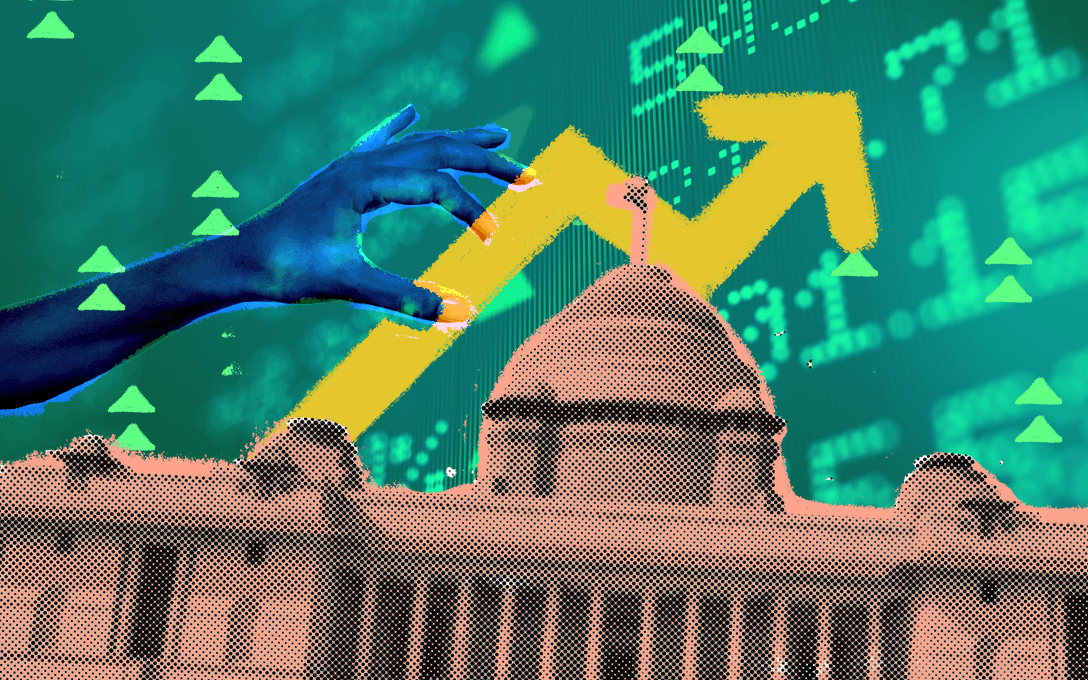
In order to ramp up economic activity that had suffered due to the Covid-19 related lockdown, the Reserve Bank of India (RBI) cut down repo rate by 0.4% on 22nd May 2020. Earlier, in March 2020 as well, the RBI had cut repo rate by a steep 0.75%, to stimulate growth. In the same month, the US Federal Reserve had cut the benchmark rates by 1% to 0.25% to help the economy recover. Recently the Federal Reserve also stated that it will hold its benchmark interest rate near zero through 2022, to help the economy recover from the coronavirus crisis.
Keeping these developments in mind, and the questions that come with it, this article hopes to tear down monetary policy and the relevance of the repo rate for you!
What is monetary policy?
Monetary policy is the policy adopted by the central bank of the country (Reserve Bank of India – in India’s case) to ensure maximum possible employment, stable prices & foreign exchange rates, and maintain a moderate level of interest rate in the long run, allowing for Gross Domestic Product (GDP) growth.
Monetary policy can either be expansionary or contractionary depending on the decision taken by the Central Bank while they assess the health of the economy.
Since the Covid-19 related lockdown started in late March 2020, consumer spending has dropped drastically. Infrastructure output as well as industrial output has also been hit. Moreover, social distancing and the fast spreading virus also forced most other countries across the world to lock itself down, resulting in a decline in India’s exports by 36.5% during May, 2020. This steep decline in aggregate demand caused a significant rise in unemployment during April and May of 2020. From the government’s perspective, the best way to deal with this situation is by adopting an expansionary monetary policy aimed at increasing economic activity thereby achieving a higher growth rate. A contractionary monetary policy on the other hand aims at lowering inflation rate by reducing the money circulating in the economy.
How do central banks conduct monetary policy?
Central banks can adopt an expansionary or contractionary policy by 2 ways. Either by influencing money supply or by changing the interest rate payable on very short term borrowings. Click To TweetThese items (Money supply and interest rates) can be influenced by one or a combination of the below tactics –
Open market operations
- These operations involve central banks buying or selling Government bonds and treasury bills in the open market with the objective of influencing money supply, thereby affecting short term interest rates.
- RBI buying securities from banks will result in more money in the hands of banks. These banks will then lend the same to retail and institutional investors thereby increasing supply of money in the economy. Since banks are flushed with cash, lending takes place at a lower interest rate.
- A lower interest rate will dissuade consumers from saving and boost spending. Business loans also become more affordable and investors can borrow and invest, thereby boosting economic growth.
- Contrary to that, when the RBI sells securities in the open market, banks invest in the same. Hence banks are left with a smaller pile of cash to lend to retail and institutional investors, cutting down the supply of money in the economy.
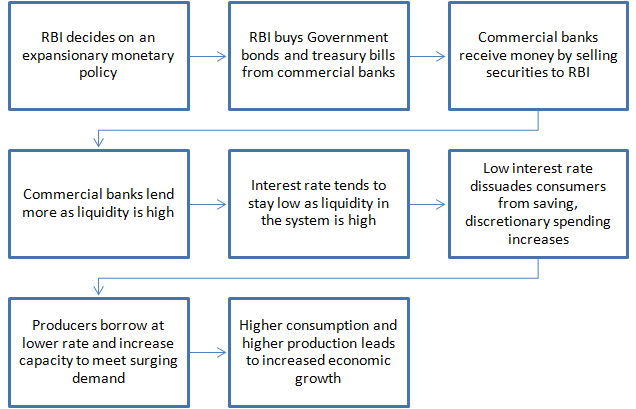
Reserve Requirements
- Central banks set the minimum amount of reserves that commercial banks must hold with the central bank. This is commonly referred to as the Cash Reserve Ratio (CRR).
- It is specified as a percentage of the net demand and time liabilities of the bank. Time liability refers to the deposits that need to be returned to the customer after a specified period, whereas demand liability is the money that is repayable to the depositors on demand. So for instance a fixed deposit in a bank is a time liability, whereas a savings bank deposit is a demand liability.
- Let’s understand this using an example – suppose the central bank sets the CRR at 3%. Let’s assume that commercial bank A has ₹1000 cr worth of demand and time liabilities on its balance sheet. Now A has to set aside ₹30 crore (3% * 1000) as reserve; this amount cannot be lent out as loan.
- If the RBI decides to decrease the CRR then a lesser amount of money will need to be held as reserve and money is freed up to lend. This has the same effect as RBI buying securities in open market operations.
- An increase in CRR has the opposite effect and holds back money from the system.
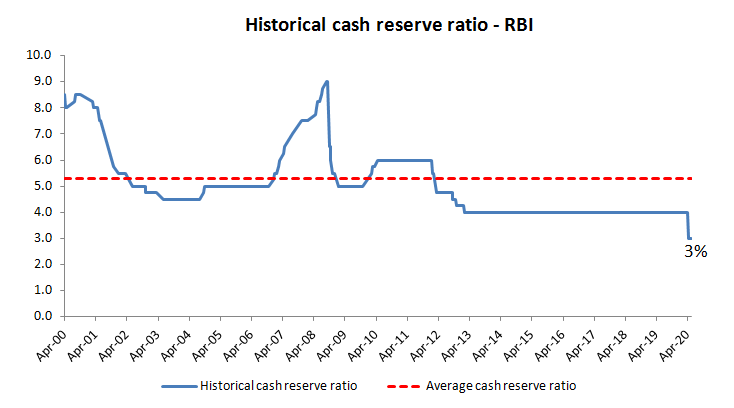
Discount Rate Manipulation
- Before jumping into discussing discount rates, it is important to understand the role of the Central Bank as the lender of last resort.
- Individuals and businesses in a country approach banks for their emergency as well as non emergency funding needs.
- On a regular basis, banks are able to manage their funding needs via demand and time liabilities as well as via issuing debt and equity. However during times of financial turmoil, when banks are facing liquidity problems, they have the option of borrowing from the Central bank of the country. Hence the RBI is the lender of last resort in India.
- In order to ensure that commercial banks are able to borrow money on a short term basis, RBI has set up a special discount window called the “Liquidity Adjustment Facility”. This facility allows banks and other primary dealers to manage their liquidity needs.
- This facility uses the repurchase (repo) option to lend or borrow money when necessary.
- A repo transaction has 2 counter parties, a seller of securities and a buyer of the same. Let’s assume that the seller is bank A and the buyer is the RBI.
- Bank A needs emergency funds of ₹ 100 crore and hence approaches RBI and proposes that the latter buy securities worth ₹ 100 crore from the former. RBI agrees to purchase the securities at ₹ 100 crore provided A promises to repurchase the same from RBI in 1 month at ₹ 100.5 crore.
- Here the Bank A is the repo borrower and sells the securities, RBI is the repo lender and buys the securities. The additional ₹ 0.5 crore that RBI gets at the end of 1 month is the interest charge. This translates to an annualized repo rate of 6% and is the rate charged by RBI to lend money to banks and other institutions. Similarly, reverse repo is the interest rate paid by RBI for money parked with it by banks and other institutions.
- The RBI decides repo and reverse repo rate in India. Currently the repo rate stands at 4% and the reverse repo rate stands at 3.35%.
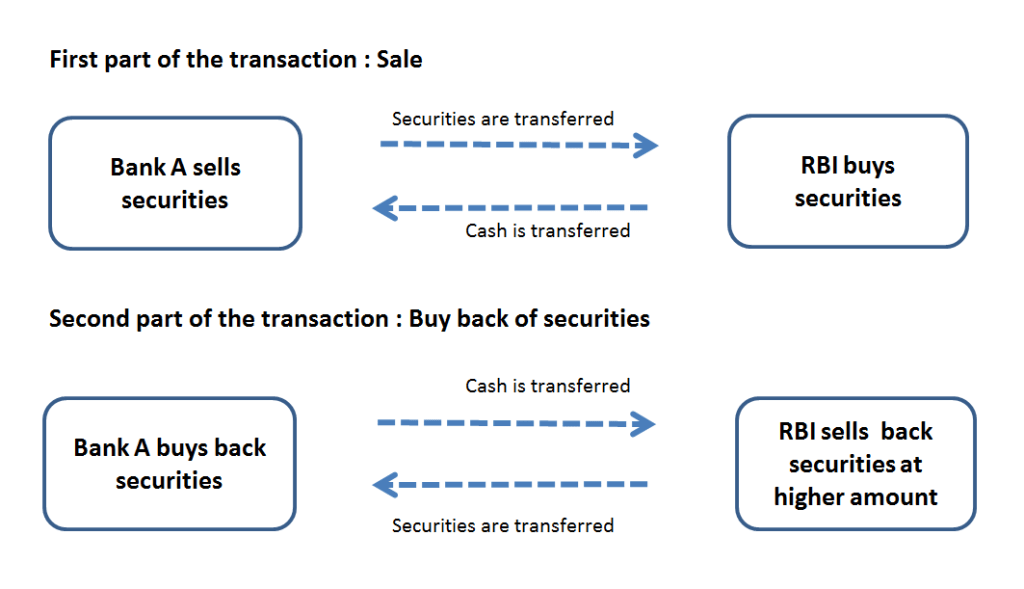
- Now that we understand what a repo rate is, let’s check out how the repo rate is manipulated to change the money supply in the economy.
- Apart from affecting the inflation rate, movement in repo rate has a significant impact on liquidity in the market. When the repo rate is marked down, banks can borrow additional funds at lower rates – as a result of this, businesses and individuals can borrow at lower rates, resulting in a probability of higher GDP growth rate.
- It is in this context, with a view to boost economic growth, that the RBI has cut the repo rate by 2.25% since Feb 2019.
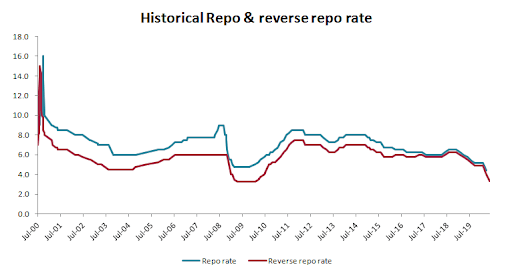
What if REPO rates are zero?
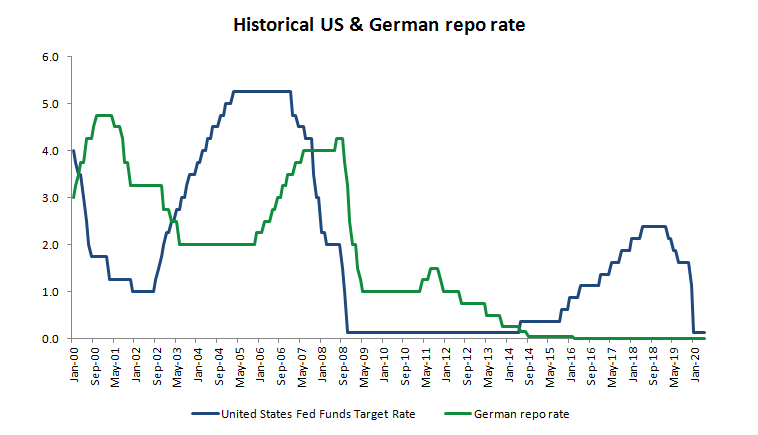
The above chart depicts the repo rate for the USA and Germany.
Repo rates in the USA were cut down close to zero in September 2008 during the financial crisis. German repo rates were also cut to near zero in Sept 2014 and have stayed flat since.
In the earlier section we saw that Central banks adopt measures like open market operations, decreasing reserve requirement or cutting repo rate to ensure that the interest rates in the market goes down, spurring economic activity. However now that the interest rates are already at near zero, what can the Central bank do to spur economic growth?
This is when Quantitative Easing (QE) comes into the picture. This policy is specifically deployed when interest rates are near zero and the conventional tool of expansionary monetary policy has failed. The standard policy would have failed for multiple reasons, however the end result is that banks will be reluctant to lend money to businesses and individuals. In such a situation the central bank starts buying securities from banks as well as other financial institutions with the intention of pumping in more money into the economy. The key difference between an open market operation and quantitative easing is that, in the former situation, central banks will buy only short term Government bonds and treasury bills. However in the latter scenario, one of the things that Central banks will do is to buy riskier assets like mortgage backed securities, credit default swaps etc. This will result in lowering the risk of commercial bank’s balance sheets, allowing these banks to lend more. Further central banks also buy more long term Government securities; this will result in the price of such securities going up due to higher demand and yield on such securities coming down. By pushing down the yield on such securities, Central banks discourage commercial banks from buying these bonds by borrowing money at the near zero short term rate.
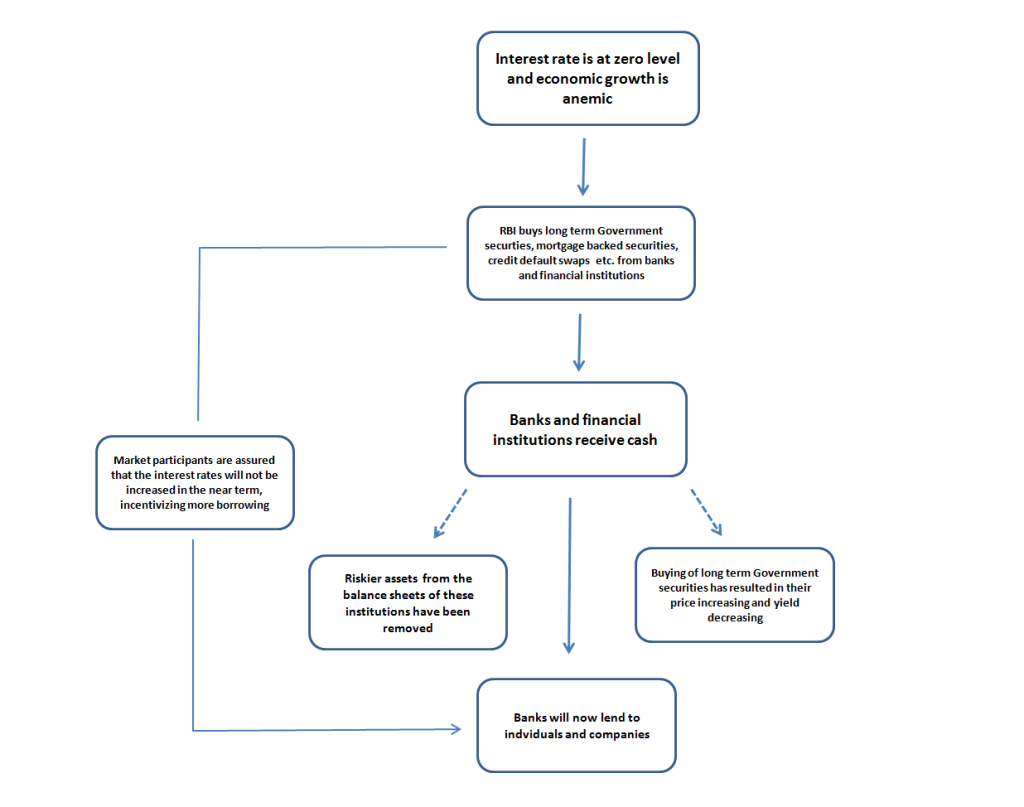
Quantitative easing affects the economy in multiple ways :
- By buying riskier securities from banks as well as other financial institutions and pushing down the yield on long term Government bonds, QE makes it profitable for banks to deploy money via loans to businesses and individuals.
- Since the interest rates are low, the Government will be able to borrow money from the markets at a lower rate and spend the same on capital formation activity.
- Capital tends to move out of a low interest economy to higher interest rate regimes. This results in selling of the local currency, resulting in it’s depreciation. A weaker currency will make the local goods cheaper in international markets thereby helping exporters.
- Quantitative easing is constructed as forward guidance regarding interest rate level. In a QE, the Central bank purchases large amounts of risky as well as risk free securities. If the short term rates are suddenly increased, then the price of these securities will fall resulting in loss to the Central Bank. Hence market participants are assured that the interest rates will not be increased in the near term.





